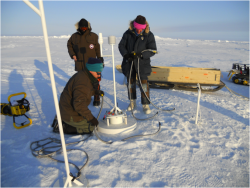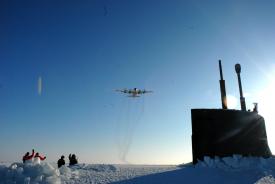The Office of Naval Research (ONR) has launched a new program in the Ocean, Atmosphere, and Space Research Division of the Ocean Battlespace Sensing Department entitled "Arctic and Global Prediction." This program, a combination of new and realigned efforts, responds to the fifth focus area of the U.S. Navy Arctic Roadmap for "Environmental Assessment and Prediction." The objective of this focus area is to "provide Navy leadership and decision makers a comprehensive understanding of the current and predicted arctic physical environment on tactical, operational, and strategic scales in time and space." The U.S. Navy Arctic Roadmap, published in November 2009, was the first product of the U.S. Navy Task Force Climate Challenge.
The goals of the Arctic and Global Prediction program are:
- Improve understanding of the physical environment and processes in the Arctic Ocean;
- Develop integrated ocean-ice-wave-atmosphere earth system models for improved prediction on time scales of years; and
- Investigate new technologies, e.g., sensors, platforms, communications, for sustained operation and observation in the challenging arctic environment.
One of the first actions of the Arctic and Global Prediction program was to announce, in February 2011, a five-year Department Research Initiative (DRI): Emerging Dynamics of the Marginal Ice Zone. The goal of the DRI is to improve the knowledge and understanding of the physics of the retreating summer ice edge and marginal ice zone (MIZ) in the Beaufort and Chukchi Seas. The approach will be to integrate data from in situ sensing platforms, remotely-sensed observations, and integrated process models to develop a comprehensive, quantitative picture of open-ocean, ice edge, and MIZ processes, interactions, and feedbacks as the ice retreats. The observational dataset that is generated will also be used to evaluate the skill of numerical models run by the Naval Research Laboratory (NRL) and academic researchers.
The announcement of the DRI included a call for planning letters, which were due on 1 April 2011, with a proposal submission deadline of 1 July 2011. ONR also accepts planning letters at any time for basic, curiosity-driven research that addresses the three Arctic and Global Prediction goals presented above.

In March 2011 the Arctic and Global Prediction program supported a variety of research activities at the Arctic Submarine Laboratory Ice Exercise (ICEX) 2011 camp in the Beaufort Sea. A joint NRL/Cold Regions Research and Engineering Laboratory (CRREL) team coordinated a combined in situ and airborne ice thickness, snow depth, and surface topography measurement campaign. Below the ice, Navy submarines obtained upward-looking sonar (ULS) ice draft data. These data will be coupled with the on-ice and airborne data to evaluate the performance of the different sensors and develop a comprehensive picture of the ice thickness distribution. Another team, from the Naval Postgraduate School, investigated under-ice hydrodynamics, particularly in the vicinity of a pressure ridge keel. The study is expected to provide new insights into mixing and drag that can be applied in models of the combined air-ice-ocean system in the Arctic.

Ice draft data obtained by Navy submarines are a contribution to Scientific Ice Expeditions (SCICEX), the Arctic Submarine Science Program, which is a partnership among the U.S. Navy, other Federal agencies, and the arctic marine science community to use nuclear-powered submarines as platforms for scientific studies of the Arctic Ocean. In addition to measuring ice draft in spring 2011, the submarines obtained underway conductivity, temperature, depth, bathymetry, and navigation data for SCICEX. There were also two SCICEX projects that tested expendable conductivity temperature depth profilers and tested procedures and calibrated equipment for routine, underway ocean biogeochemistry measurements.
To read the 2009 U.S. Navy Arctic Roadmap, please see: http://greenfleet.dodlive.mil/files/2010/08/US-Navy-Arctic-Roadmap-11-1….
For more information about Task Force Climate Change and the Arctic Roadmap, please contact Bob Freeman (robert.freeman [at] navy.mil).
Further information about the ONR Arctic and Global Prediction Program and submission of planning letters can be found at: http://www.onr.navy.mil/Science-Technology/Departments/Code-32/All-Prog… or contact Martin Jeffries (martin.jeffries [at] navy.mil), or Scott Harper (scott.l.harper [at] navy.mil).
